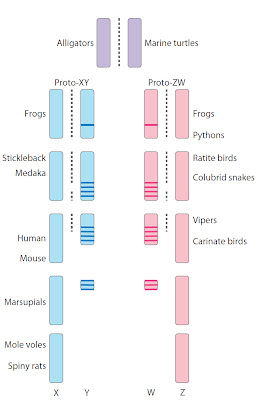Contributed by: Zhenguo Lin
In the first half of the 20th century,
chemical pesticides began to be widely used to control a variety of pest
species. In her 1962 groundbreaking book Silent Spring, Rachel Carson argued that
insects are building up resistance to pesticides. Sadly, as Carson foretold, cases
of resistance surfaced within two to 20 years after the introduction of every kind
of new insecticide.
It is generally believed that the development of
pesticide resistance is generated by changes of genetic information in the
pest's genomes and it takes many generations for the pesticide resistant genes to
spread in the population. However, some short cuts of acquiring pesticide resistance
actually exist. As discussed in my previous
blog, it is found that European house mice stole a rodenticide resistant
gene through hybridization with Algerian mice (1). In a recent PNAS paper (2) ,
Kikuchi et al. found an unexpected mechanism of rapid acquisition of insecticide
resistance from bacterial symbionts in bean bugs and stinky bugs, which are
major pests in agriculture.
Fenitrothion
is an organophosphate insecticide
that acts as an inhibitor of cholinesterase, so that the nerve function is
damaged in insects, humans, and many other animals. Fenitrothion has been
heavily used to kill a wide range of pests. However,
it has been found that repeated application of fenitrothion leads to rapid
increase of fenitrothion-degrading microbes, including some species in the bacterial
genus of Burkholderia. These bacteria
are able to breakdown feritrothion into products that can be used as their carbon
source.
Burkholderia are able
to inhabit prosperously in the midgut of the bean bugs as symbionts. The
infected bean bugs tend to grow bigger than uninfected bugs, showing mutual
benefits of symbiosis. Kikuchi et al. infected
the bean bugs with six different Burkholderia
species (strains): three of them are fenitrothion-degrading and the others are non-degrading
(Figure 1) . They found that the bean bug infected with fenitrothion-degrading Burkholderia has much higher survival
rates than those bugs infected with non-degrading Burkholderia, because the degraded fenitrothion is almost non-toxic
to bugs. This study indicates that the insects can become resistant to
fenitrothion instantly after they swallow these fenitrothion-degrading bacteria.
Interestingly,
unlike many other insects, the offspring of bean bugs does not inherit Burkholderia from their mothers. The bean
bugs need to pick the Burkholderia symbionts
from surrounding soils each generation before reaching the adult stage. This
seems to be inefficient, but it reduces the possibility that the
fenitrothion-degrading bacteria become so dependent on their hosts that they lose
their chemical-detoxifying genes. In addition, the authors found that the
resistant Burkholderia species can
increase rapidly in soil after treated with fenitrothion even though these
bacteria are very rare in natural environments. The fenitrothion-degrading species
rapidly become the most dominant group (>80%) in the Burkholderia population after merely one month of fenitrothion
treatment. Therefore, bean bugs can easily acquire pesticide resistance because
the resistance may have already developed in the bacterial population even before
the arrival of insects. In addition, considering that the highly diversified
enzymatic functions of bacteria are able to detoxify many different pesticide, the
acquisition of instant pesticide resistances from these bacterial symbionts
will definitely bring new challenges for the efficiency of insecticides.
 |
|
Figure 1.
Insecticide resistance
of R. pedestris infected with
fenitrothion-degrading Burkholderia strains. (A and B) Survival of third instar nymphs of R.
pedestris infected
with the fenitrothion-degrading and nondegrading Burkholderia strains when reared on
fenitrothion-coated soybean seeds. Results under the host genetic background
TKS-1 (A) and TKA-7 (B) are shown. Mean and SE
of 10 replicates are indicated at each data point. Each asterisk indicates that
survival rate of the insects infected with the fenitrothion-degrading Burkholderiastrain is significantly higher than survival rate of the insects
infected with the allied nondegrading strain (likelihood ratio test; P < 0.01). (Cand D) Resistance of Burkholderia-infected R. pedestris to percutaneous application (C) and oral
administration (D) of fenitrothion. Third
instar nymphs, which were infected either with the fenitrothion-degrading Burkholderia strain (SFA1) or with the nondegrading Burkholderia strain (RPE67), were administrated with 30 pmol of fenitrothion,
and their survival was inspected 24 h later. On each of the columns is shown
number of surviving insects/total number of treated insects. Statistically
significant differences in the survival rates are shown (Fisher’s exact
probability test). (2)
|
References
1. Song,
Y., Endepols, S., Klemann, N., Richter, D., Matuschka, F.R., Shih, C.H., Nachman, M.W.,
and Kohn, M.H. 2011. Adaptive introgression of anticoagulant rodent poison resistance by hybridization between Old World mice. Current Biology
21:1296-1301
2. Kikuchi
Y, Hayatsu M, Hosokawa T, Nagayama A, Tago K, Fukatsu T. 2012.
Symbiont-mediated insecticide resistance. Proc Natl Acad Sci USA 109:8618–8622
3. Kikuchi Y,
Hosokawa T, Fukatsu T. 2007. Insect-microbe mutualism without vertical transmission: A stinkbug acquires a beneficial gut symbiont from the environment every generation. Appl Environ Microbiol 73:4308–4316
